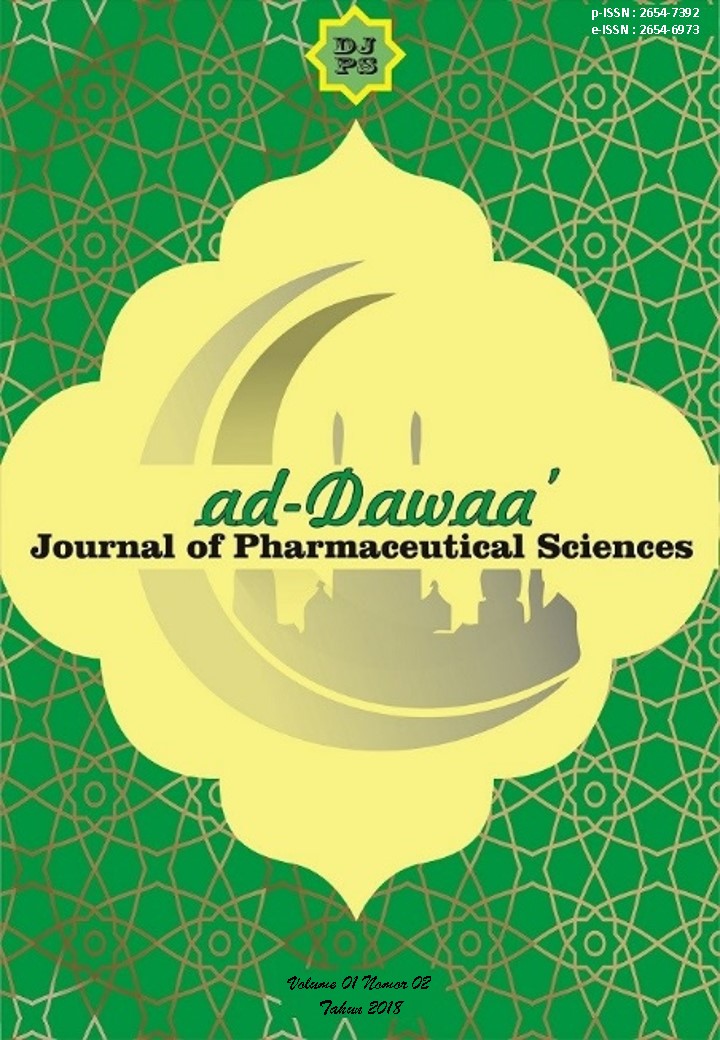Efek Hipoglikemik Ekstrak Etanol Daun Kelor (Moringa oleifera L.) pada Tikus Putih (Rattus norvegicus) Jantan
Abstract
Daun Kelor (Moringa oleifera L.) secara empiris digunakan oleh masyarakat sebagai antidiabetes. Penelitian ini bertujuan untuk menentukan pengaruh pemberian ekstrak etanol daun kelor terhadap penurunan kadar glukosa darah tikus putih. Penelitian ini menggunakan 15 ekor tikus jantan yang dibagi menjadi 5 kelompok. Kelompok I merupakan kontrol negatif yang diberikan larutan Na.CMC 1%. Kelompok II, III dan IV adalah kelompok perlakuan yang diberikan ekstrak etanol daun kelor, berurutan, 50, 100, dan 150 mg/Kg BB. Kelompok V merupakan kontrol positif diberikan suspensi glibenklamid®. Sebelum perlakuan tikus dipuasakan selama 18 jam kemudian diinduksi dengan aloksan 150 mg/KgBB. Pengukuran kadar glukosa dilakukan pada hari ke 1, ke 3, ke 5, ke 7 dan ke 9. Hasil penelitian yang dilakukan menunjukkan ekstrak etanol daun kelor dapat menurunkan kadar glukosa darah. Dosis 100 mg/Kg BB memberikan efek penurunan kadar glukosa yang optimal dibandingkan dengan dosis ekstrak lainnya.
Downloads
References
Aminah, S., Ramdhan, T., & Yanis, M. (2015). Kandungan Nutrisi dan Sifat Fungsional Tanaman Kelor (Moringa Oleifera). Buletin Pertanian Perkotaan, vol 5, no 2, pp 38.
Anwar, F., Latif, S., Ashraf, M., & Gilani, A. H. (2007). Moringa oleifera: a food plant with multiple medicinal uses. Phytotherapy Research, 17-25.
Chinedu, A. A., Alani, S. O., & Olaide, A. O. (2015). Effect of the Ethanolic Leaf Extract of Moringa oleifera on Insulin Resistance in Streptozotocin Induced Diabetic Rats. Journal of Plant Sciences, 5-12.
Departemen Kesehatan RI. (2000). Buku Panduan Teknologi Ekstrak. Jakarta: Dirjen POM-Depkes RI.
Estrella, M. C., Mantaring, J. B., David, G. Z., & Taup, M. A. (2000). A Double Blind Randomized Controlled Trial on The Use
of Malunggay (Moringa Oleifera) for Augmentation of The Volume of Breast milk Among Non-Nursing Mothers of Preterm Infants. Philipp J Pediatr, 49: 3-6.
Jaiswal, D., Rai, P. K., Kumar, A., Mehta, S., & Watal, G. (2009). Effect of moringa oleifera lam leaves aqueous extract therapy
on hyperglycemic rats. Journal of Ethnopharmacology, 392-396.
Luqman, S., Srivastava, S., Kumar, R., Maurya, A. K., & Chanda, D. (2012).
Experimental Assesment of Moringaoleifera Leaf and Fruit for Its Antistress,Antioxidant, Scavenging Potential UsingIn Vitro and In Vivo Assays. Hindawi Publishing Corporation Evidence-Based
Complementary and Alternative Medicine,1-12.
Parrott, E. (1979). Pharmaceutical
Technology Fundamental Pharmaceutics.
Minnepolis: Burgess Publishing Company.
Siddhuraju, P., & Becker, K. (2003). Antioxidant properties of various solvent extracts of total phenolic constituents from three different agroclimatic origins of drumstick tree (Moringa oleifera Lam.) leaves. Journal of Agricultural and Food Chemistry, 2144-2155.
Tahiliani, P., & Kar, A. (2000). Role of Moringa oleifera leaf extract in the regulation of thyroid hormone status in adult male and female rats,. Pharmacological Research, 319-323.
Trubus Edisi Agustus. (2011). Biology and Medicine. 27-35.
Wang, Y., Gao, Y., Ding, H., Liu, S., Han, X., Gui, J., & Liu, D. (2016). Subcritical ethanol extraction of flavonoids from
Moringa oleifera leaf and evaluation of antioxidant activity. Journal Food Chemistry, 152-158.
Wasito, H. (2011). Obat Tradisional Kekayaan Indonesia. Yogyakarta: Graha Ilmu.
Once an article was published in the journal, the author(s) are:
- granted to the journal right licensed under Creative Commons License Attribution that allows others to share the work with an acknowledgement of the work's authorship.
- permitted to publish their work online in third parties as it can lead to wider dissemination of the work.
- continue to be the copyright owner and allow the journal to publish the article with the CC BY-SA license
- receiving a DOI (Digital Object Identifier) of the work.


1.png)